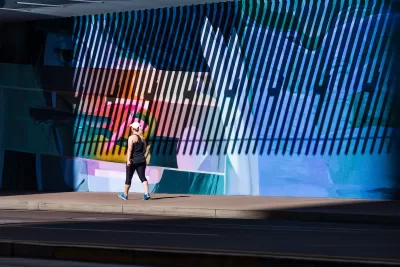Coatings that reflect heat can make the air feel warmer for people standing on and around these surfaces.

New research from Arizona State University delves into the complicated impacts of cool pavement treatments, which can reduce surface temperatures in concrete-heavy urban areas but can also increase the “thermal stress” felt by a person standing on these heat-reflective surfaces and are thus not appropriate for all areas.
Writing in Smart Cities Dive, Ysabelle Kempe explains, “Cool pavement technology is most effective on large parking lots that lack shade or in car-centric cities with hot climates, low cloud cover and wide residential streets, the researchers say. It’s not effective in high-rise downtown areas and shouldn’t be used in areas with high pedestrian traffic like playgrounds, plazas or parks, they add.”
In essence, the treatments have a bigger effect on the surface they’re applied to than on the ambient temperature for people walking on them. “Experts say these types of results indicate cool pavement is not a solution to rising heat-related illness and death tolls. Indeed, the researchers in Phoenix say that installing cool pavement in areas with high pedestrian traffic could be considered a ‘maladaptation’ in regards to the experience of pedestrians,” inadvertently putting people at higher risk for heat-related illnesses.
The study suggests that cities’ heat mitigation strategies should focus more on trees and other ways to create shade.
FULL STORY: Phoenix cool pavement study shows technology tradeoffs

Planetizen Federal Action Tracker
A weekly monitor of how Trump’s orders and actions are impacting planners and planning in America.

Chicago’s Ghost Rails
Just beneath the surface of the modern city lie the remnants of its expansive early 20th-century streetcar system.

San Antonio and Austin are Fusing Into one Massive Megaregion
The region spanning the two central Texas cities is growing fast, posing challenges for local infrastructure and water supplies.

Since Zion's Shuttles Went Electric “The Smog is Gone”
Visitors to Zion National Park can enjoy the canyon via the nation’s first fully electric park shuttle system.

Trump Distributing DOT Safety Funds at 1/10 Rate of Biden
Funds for Safe Streets and other transportation safety and equity programs are being held up by administrative reviews and conflicts with the Trump administration’s priorities.

German Cities Subsidize Taxis for Women Amid Wave of Violence
Free or low-cost taxi rides can help women navigate cities more safely, but critics say the programs don't address the root causes of violence against women.
Urban Design for Planners 1: Software Tools
This six-course series explores essential urban design concepts using open source software and equips planners with the tools they need to participate fully in the urban design process.
Planning for Universal Design
Learn the tools for implementing Universal Design in planning regulations.
planning NEXT
Appalachian Highlands Housing Partners
Mpact (founded as Rail~Volution)
City of Camden Redevelopment Agency
City of Astoria
City of Portland
City of Laramie





























